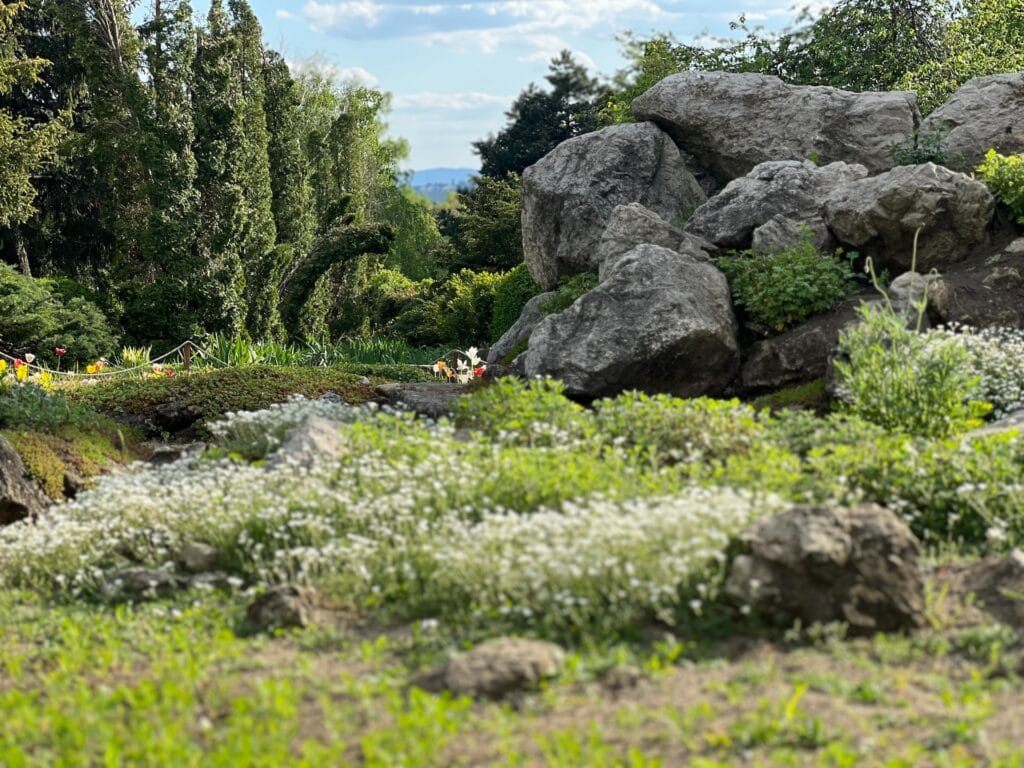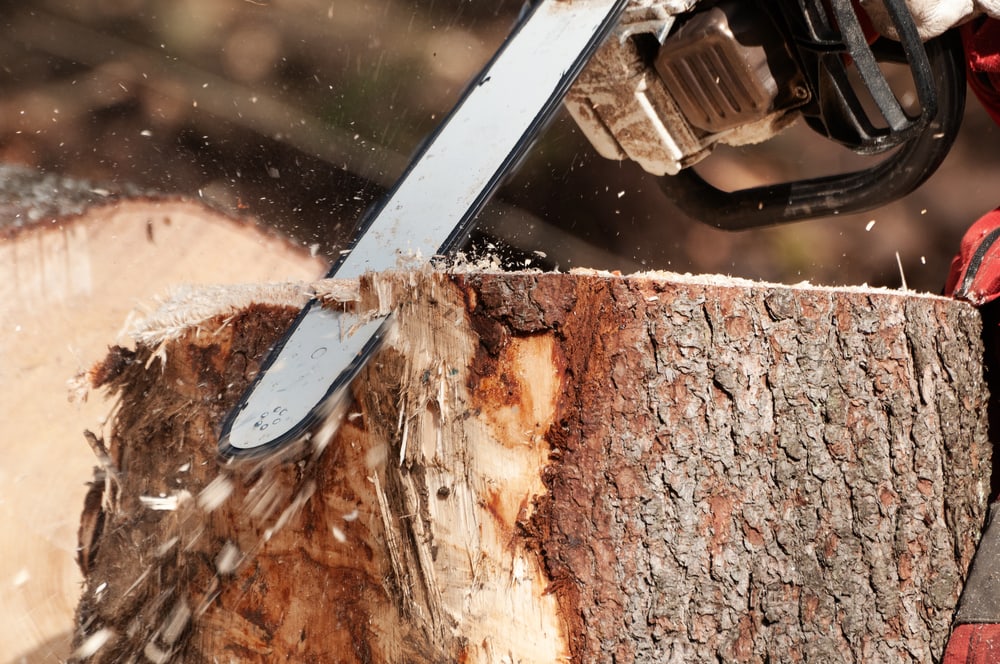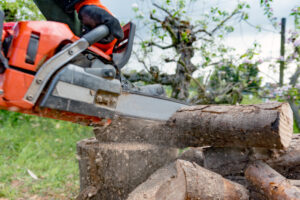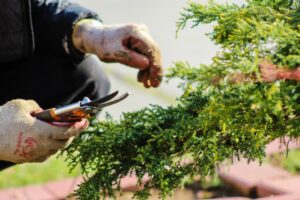Have you been seeking out the most effective way to clear the overgrown forested land you have and make it into more useable space, but you are concerned that it would cost you an arm and a leg to do so? When you tried to get your land cleared the last time, was the process laborious and frustrating, and now you're looking for a solution that's a little bit simpler? If this is the case, then you may put your concerns to rest. You could discover the answer in the mulching of forest trees.
The job of clearing land typically comes with a lot of worries attached to it. The expense of the procedure, the amount of manual labour required, and the vast number of tasks that need to be carried out might all feel overwhelming. The substantial amount of time that is consumed, the need to fuel the machines, and the damage done to the environment are all factors. Forestry mulching is an option for land clearing that is less difficult, requires less time and money, and eliminates the environmental dangers that are associated with it. This is because it is able to cut through each of these concerns simply.
It is helpful to have an idea of what to anticipate if you are thinking of clearing your land with forestry mulching, which you should be doing. Check out our comprehensive guide to the mulching of forests.
What Is Forestry Mulching?
After a project to clear the land of its vegetation, organisations that specialise in forestry mulching offer a method that is more effective for eliminating the remaining plant material. Instead of carrying away the downed trees and branches, they are transformed into mulch right there on the spot, which includes the bushes, trees, and grasses. Forestry mulching is typically used to clean and maintain the vegetation in a woody region, with the goal of preventing the further spread of invasive species and improving the overall health of wildlife.
Forestry mulching is the process of converting the lingering vegetation in a region, such as brush, trees, short grassy foliage, and heavy limbs, into a top layer of ground cover that is natural and good for the environment. The procedure, which is more often known as mulching, does away with the requirement for a number of different tools, including bulldozers, excavators, tree shears, grinders, wood chippers, and hauling equipment. Instead, forestry mulching involves using a single machine to chop, grind, and remove away vegetative growth and saplings, leaving behind a blanket of mulch that has been shredded into smaller pieces.
This protective covering of organic material is allowed to decompose and be reintroduced into the soil, which results in the soil being richer and more fruitful. The biodegradable top layer (mulch) transforms into a natural protective barrier over the soil, which helps to maintain the ground's stability, stops soil erosion, and promotes the growth of native plants.
Why do forests mulch?
- Topsoil preservation – Mulching in forests stops the topsoil from washing away, which would otherwise be the result of soil erosion. When mulches are left in place, they eventually decompose and add nutrients to the soil. When the soil's natural configuration is not disrupted, the risk of soil erosion is reduced.
- Efficiency – Forestry mulchers are effective machinery that can be used to accomplish jobs that might not be possible using more conventional approaches. Because some land sizes, soil structures, topographies, and weather circumstances don't allow traditional ways of clearing land, forestry mulching becomes an efficient alternative.
- Applied directly – Forestry mulching is performed efficiently and directly to the plants that are intended without causing any harm to the ecosystem or the soil.
- Time conservative – In contrast to more conventional practices, forest mulching is efficient in terms of time management. When more work is completed in a shorter amount of time, this results in cost savings and makes it possible for further economic gains. It is possible to complete activities that often take a longer amount of time in a short amount of time, such as cutting, brushing, and clearing.
- Economic – Mulching trees in a forest is both cost-effective and efficient, as it reduces the need for heavy machinery like bulldozers. There is less of a propensity to rely on more substantial pieces of machinery. While using a Forestry mulcher, there is only a requirement for a single machine, which results in a reduction in the number of combustions, gas emissions, and fuel consumption.

Who Benefits From Forestry Mulching?
In addition to cleaning up farmlands, gardens, backyards, and other private areas, forestry mulching can be beneficial for achieving other land development and environmental goals. The following are some of the ways that other projects can benefit from forestry mulching.
Clearance of Public and Commercial Land
Mulching is becoming an increasingly common practice in public, commercial, and residential land-clearing projects. These projects include the development and preparation of construction sites, the establishment of nature and recreational paths, and the assistance of seismic research. Right-of-way clearing, as well as the maintenance of roads and highways, pipelines, and utility lines, all of which frequently require the total removal of all standing vegetation, are typical applications for this method.
Ecology of Wetlands and Riverbanks (Riparian Zone): Protection of Habitat
Because of its low impact on the surrounding ecosystem, forestry mulching is becoming increasingly popular among private landowners, nonprofit riparian conservation organisations, hunting clubs, and government agencies as part of their efforts to preserve habitats for pheasants, elk, doves, and deer, as well as other species of wildlife.
The Welfare of Animals
The requirements of the various animal species that call the forest their home can more easily be met by controlling the growth of the vegetation thanks to mulching. In the following ways, it contributes to the well-being of several animal species.
Food. The underbrush and invasive species, such as buckthorn and multiflora rose, are removed by mulching devices used in the forest, such as mulchers and mowers. This makes it possible for grasses and other plant materials that herbivores eat to grow and thrive.
Water. There are instances when animals are unable to access their water sources because they have become blocked by an excessive amount of undergrowth caused by trees. Mulchers and tree shears are two tools that can be used to help restore access to water for these animals.
Shelter. Some kinds of grasses are essential to the survival of certain species by providing them with a habitat, a place to breed, and protection from the effects of severe temperatures. The removal of invasive undergrowth through mulching can make way for the growth of grasses that are necessary for animals.
Invasive Species Control
Plants and insects that have invaded another habitat can make conditions very difficult for the native ecology. Invasive plant species have the potential to spread throughout an area and consume a significant amount of groundwater. The removal of these plants contributes to the protection of the water table. The tamarisk (also known as salt cedar), Juniperus virginiana, the Pinyon-juniper (PJ), buckthorn, and the multiflora rose are all examples of common invasive plant species.
Pine beetles and other invasive insects are capable of wreaking havoc on forests, leaving behind rotting trees that are worthless as lumber. When these withering trees lose the ability to endure the wind, they pose a risk of having branches or even the entire tree fall. The use of mulch preventatively relieves the strain that is placed on trees as a result of overpopulation, which in turn strengthens the plants' natural defences against the attacks of these destructive species.
The proliferation of invasive plants, insects, and fungi can be stopped via mulching. During the mulching process, the discharged material that was left behind settles inside a region that is quite limited. This is contrary to what rotary cutters do, which spread pine beetles and other invasive species laterally into healthy trees that are nearby. This prevents the spread of these pests.
Wildfire Management And Prevention
The risk of wildfires can be reduced by using mulch in a proactive manner. It gets rid of small leafy plants, dead or rotting trees, and other fuel sources that could potentially act as kindling for wildfires. In addition, reactive mulching, sometimes known as fire breaks, which refers to the reactive cutting of lines on active fires, is one method that can be utilised to control wildfires.
What Benefits Does Forestry Mulching Offer?
If you're curious about the rationale for the practice of forest mulching, it's because of the many advantages it possesses over more conventional approaches.
The following are a few of its many benefits:
- It is quick and inexpensive.
The mulching of forests is a simple operation that consists of only one stage, and it is especially basic for mulching smaller regions.
You do not require a number of different machines in order to prepare the site, cut, fell, haul, or clean up the site.
Instead, there is just one machine that is capable of doing everything, and any new vegetation is turned into a nourishing ground layer that can remain in place.
There is no waste that has to be removed.
The use of fewer machines and more manual labour will result in significant time and financial savings.
It is possible to carry it out in any environment, regardless of the terrain or the weather.
- It may be done in any climate and on any surface.
The process of forest mulching may be carried out in even the most difficult terrains and weather, regardless of whether it is hot or cold, wet or dry.
You'll find that many businesses mulch even on steep slopes, in poor soil, and even when it's raining or snowing outside.
- It is waste-free and environmentally friendly.
When land is cleared using traditional methods, the soil is typically disturbed in some way, which increases the likelihood of erosion occurring.
When a mulching technique is utilised, the structure of the soil is not disturbed, and the material that is mulched serves as a barrier against soil erosion.
- The number of ticks declines.
Ticks are a nuisance that should be avoided in any natural situation they are found.
While leaving a densely wooded region, it is probably common knowledge that you should inspect both your clothing and your skin for any signs of ticks.
You can cut down on the number of ticks that live in an area by removing ground and mulching it first.
- It prevents weeds from growing.
Do you have a hard time controlling the weeds on your land?
In that case, you should try forest mulching.
While using this technique, the topmost layer of the soil is covered with shredded vegetation, which prevents sunlight from reaching any weeds that may have been left behind.
This not only causes them to perish, but the heat that is produced as a result of the shreds decaying also helps to eliminate any weeds that may have survived.
- The soil benefits from it.
Instead, it acts as a blanket for the topsoil, preventing it from being exposed to the natural forces that lead to soil erosion (i.e., high winds or rainstorms).
The process of mulching does not topple trees but does disrupt the structure of the soil, which in turn increases the rate of soil erosion.
So, you will observe water conservation as a result of a reduction in the amount of moisture that is lost from the soil.
Landowners who utilise mulching frequently improve the fertility of their soil by giving critical nutrients that are beneficial to the growth of future vegetation. This is possible due to the fact that mulch is an organic material that decomposes over time. If you are not sure that you can handle the care yourself, get in touch with us, we will definitely help

What Are The Disadvantages Of Forestry Mulching?
Forest mulching is helpful for various reasons. It feeds the soil while removing it from undesired vegetation overgrowth. But, it is not devoid of restrictions in any way. Here are some of its downsides that you might want to consider:
- Careful consideration must be given to the mulch kind.
The organic material that will finally become mulch needs to be properly estimated in order to ensure that young plants are able to develop healthily and thrive without encountering any resistance.
Keep in mind that the production of mulch requires a variety of various kinds of organic materials.
These include things like sawdust, grass, leaves, twigs, straw, and other types of softwood and hardwood.
Incorrectly calculating the quantities of these materials can lead to outcomes that are less than desired.
- Not every property benefits most from mulching.
It's possible that applying forest mulch to your land is not the greatest choice.
Mulching can be a time-consuming task, especially if you have a huge region that is densely wooded and of a greater size.
It will call for a significant investment of time and resources.
The procedure is only successful when the land in question contains fewer than 25 tons of vegetation or 100 trees per acre and uses the most powerful forestry mulching machines that are now available.
Although mulching is a more efficient method for clearing the area than doing it by hand, the property still has to have road access in order to have access to fuel and to maintain the mulchers.
If you are located in a remote place, this may be a challenge for forestry mulching; therefore, you should keep this in mind when you make selections regarding your project.
- Mulch is a good place for creatures to breed.
This is a possibility, a limited one. There are species, such as earthworms, that are beneficial to the soil and the crops that are grown in it.
On the other hand, there are organisms that can cause disease and hazardous pests that are able to thrive and reproduce there.
When you mulch, you want to make sure you do it in a method that doesn't provide any hazardous organisms with the opportunity to increase and pose a risk to the soil in your yard and around your house.
If necessary, get in touch with a business that specialises in preventing the reproduction of pests.
- When carried out incorrectly, forest mulching may endanger the soil.
To stop nitrogen from leaching out of the soil, organic mulches must be applied in a state that is either crumbly or partially decomposed before they can be utilised.
If mulch breaks down through a process called anaerobic decomposition, it has the potential to become "sour" and cause harm to the plants that it is intended to shield from harm.
- A lot of organic material is needed to make a little mulch.
Even a small amount of mulch requires a large amount of organic matter, and some properties may not have enough organic matter to provide mulch for the entire area.
The large amount of natural matter that must be used presents the vast majority of challenges when mulching.
The quantity of organic matter decreases as it decomposes, and so does the mulch as a result.
There is a good chance that you won't be able to mulch your soil adequately if your property does not have enough amount of vegetation.
- Different plants and terrain may necessitate different equipment.
For the purpose of forestry mulching, some of the pieces of machinery that would need to be utilised include skid steer tractors fitted with mulching attachments, tracked mulching equipment, and excavator mulchers.
Because they are not designed to process boulders and stones, forestry mulching machines are not suitable machinery to use in this situation. The proper machinery will vary based on the vegetation and the terrain.
In point of fact, crushing rocks against the teeth of the mulcher can cause damage to the teeth as well as create a potential fire hazard.
- Forest mulching is generally safe. However, there are hazards.
Debris and small stones can be launched into the air when the machine is operating, which poses a risk to nearby pedestrians and drivers.
Even though mulchers typically feature protective shrouds to cover their users from flying debris, it is still possible for them to pose a threat to individuals or structures in the surrounding area.
3 Pieces Of Equipment For Forestry Mulching
The mulcher attachment is the most important piece of machinery you will require for forest mulching. But, you will need a machine that you can attach it to in order to use it. Other types of machinery, such as brush chippers, are also capable of producing mulch.
1. Mulcher Attachments
Attachments for mulchers are vital pieces of machinery that are intended to get rid of vegetation. They will dispose of any organic waste that is present on the ground at your work location, transforming it into a biomass product known as mulch. You are able to chop and mulch overgrowth, saplings, trees, and shrubs with the help of Mulcher attachments.
The heads of mulcher attachments are useful and durable, and they are able to mulch trees with a diameter of up to 8 inches. They come with a motor that can switch between two speeds and a push frame that can be adjusted. Even the part of the teeth that will really accomplish the cutting can be controlled by you.
2. Skid Steers
The skid steer is a reliable piece of machinery to go with. Skid steers are durable, versatile equipment that can do a wide range of tasks and are compatible with a wide variety of accessories, including mulchers.
You have your choice of several different skid steer models. Caterpillar's skid steers come equipped with high-performance power trains and roomy, comfortable cabs to keep the operator safe while they are on the job. These skid steers are also designed to maximise productivity. Mulching in the forest is an ideal use for skid steers because of its versatility and ability to operate on a variety of terrains.
3. Brush Chippers
This is an additional option for the mulching of forest waste. These machines function in a manner that is analogous to that of mulchers. The fundamental distinction lies, in fact, in their objectives of undesired materials at a construction site. The pieces of wood that are hacked off of shrubs, small trees, and branches have been removed and can frequently be used as mulch.
Final Thought
In conclusion, forest mulching is an excellent method for clearing land for a variety of different applications. While land clearing can be useful for a variety of purposes, including the development of new agricultural land, forest mulching is the most environmentally responsible option. If you want to get the most out of your land-clearing operation, you must seek the advice of a professional, no matter which option you select.
Frequently Asked Questions
How long does it take for the mulched area to regenerate and regrow?
The regrowth timeline after forestry mulching can vary depending on factors such as climate, soil conditions, and the specific plant species in the area. Generally, some vegetation regrowth can be observed within a few weeks to a couple of months. However, complete restoration of the area may take several months or even years. To accelerate the regrowth process, applying appropriate seed mixtures or planting native species can be beneficial.
Can forestry mulching be used in all types of terrain?
Yes, forestry mulching is highly adaptable and can be used in various terrains. The equipment used for forestry mulching is designed to navigate challenging landscapes, including steep slopes, wetlands, and rough terrain. This versatility makes it suitable for a wide range of applications, such as residential and commercial development, right-of-way maintenance, and land restoration projects.
Is forestry mulching an effective method for controlling invasive species?
Yes, forestry mulching can be an effective tool for managing invasive species. The mulching process helps to remove and break down invasive plants, preventing them from spreading further. Grinding the vegetation into mulch disrupts the growth cycle of invasive species and reduces their ability to re-establish. However, it's important to note that some invasive plants may have resilient root systems, and additional management techniques might be necessary to eradicate them fully.
Can I use the mulch generated from forestry mulching for other purposes?
Yes, the mulch generated from forestry mulching can be utilized for various purposes. The mulch acts as a natural ground cover, helping to control erosion and retain moisture in the soil. It can also provide insulation for plant roots, protecting them from extreme temperatures. Additionally, the mulch can be utilized for landscaping projects, such as creating walking paths, garden beds, or decorative areas.
What are the potential limitations or challenges of forestry mulching?
While forestry mulching offers numerous benefits, there are a few potential limitations and challenges to consider. Dense vegetation or large trees may require multiple passes with the mulcher to achieve effective clearing. In some cases, certain tree species with extensive root systems may produce stump sprouts, necessitating additional treatment. Additionally, rocky terrain or areas with buried debris may pose challenges to the mulching equipment and require site preparation.







